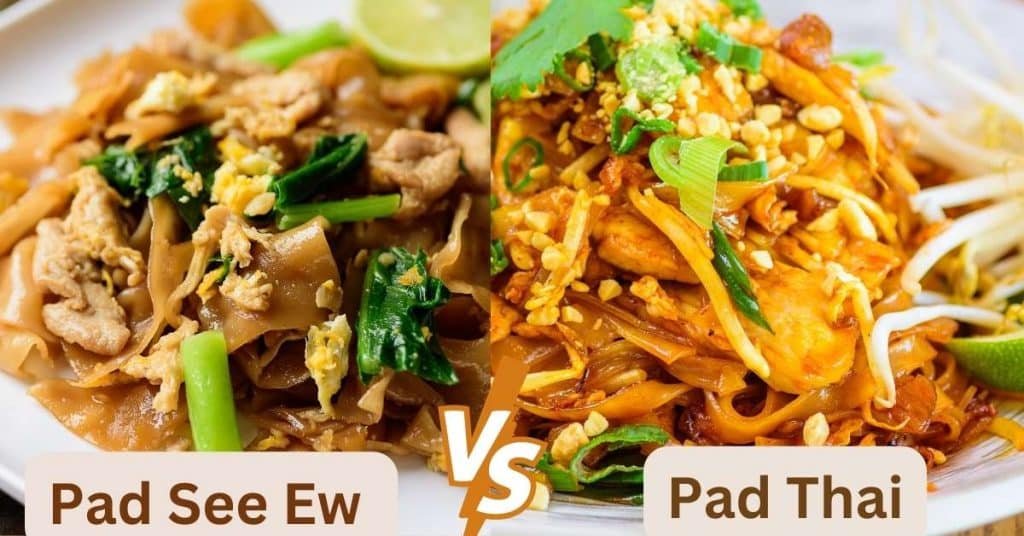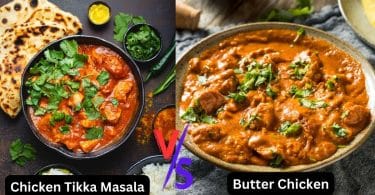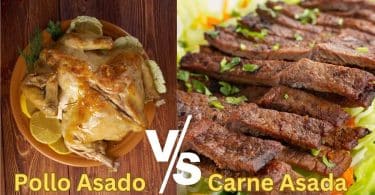Welcome to the vibrant and flavorful realm of Thai cuisine, where each dish tells a story of tradition, culture, and taste. Two of Thailand’s most cherished dishes are Pad See Ew and Pad Thai, noodle dishes that have gained worldwide fame for their appetizing combinations of ingredients and flavors. However, they are not interchangeable, each offering a unique culinary experience. In this blog post, we will journey into the heart of Thai cuisine, contrasting Pad See Ew and Pad Thai, examining their ingredients, their taste profiles, and their historical and cultural significance.
Pad See Ew vs Pad Thai: The Battle of the Noodles
The main difference between Pad See Ew and Pad Thai is that they feature distinct ingredients and flavor profiles, and they utilize different types of noodles. Pad Thai is typically prepared with thin rice noodles and includes a variety of ingredients like tofu or shrimp, bean sprouts, peanuts, and scrambled eggs. It uses a tamarind-based sauce, which provides a blend of sweet, tangy, and salty flavors. On the other hand, Pad See Ew uses wider rice noodles and a more straightforward set of ingredients such as a choice of chicken, beef, or tofu, and Chinese broccoli, all stir-fried in a dark soy sauce blend. This dish leans more towards a savory, hearty flavor.
Variations in Preparation and Serving
Another difference between these two popular dishes lies in their preparation and serving styles. Pad Thai often includes a garnish of lime wedges, fresh cilantro, and crushed peanuts, which are added at the end, enhancing its vibrant taste. In contrast, Pad See Ew is typically served as is, letting the flavorful soy sauce and the tender ingredients shine without the need for additional garnish.
Textural Contrasts
Texturally, Pad See Ew and Pad Thai also offer different experiences. The thin rice noodles in Pad Thai absorb the tangy-sweet sauce, creating a softer texture. The added crunch from fresh bean sprouts and peanuts offers a nice contrast. In Pad See Ew, the wider noodles have a more substantial, chewy texture that soaks up the dark soy sauce, making each bite savory and satisfying.
Cultural Significance and Popularity
Lastly, the cultural significance and popularity of the two dishes vary. Pad Thai, often celebrated as Thailand’s national dish, is usually the first introduction to Thai cuisine for many foreigners. Meanwhile, Pad See Ew, although slightly less recognized globally, holds its own as a popular comfort food in Thailand, particularly as a street food favorite.
Understanding Pad See Ew
Delving deeper into Thai cuisine brings us to one of its popular noodle dishes, Pad See Ew, a hearty, savory dish beloved for its simplicity and taste.
What is Pad See Ew?
Pad See Ew, which translates to “fried soy sauce,” is a stir-fried noodle dish known for its distinct, robust flavors. It’s often eaten as a quick lunch or dinner and is a popular street food in Thailand.
Key Ingredients of Pad See Ew
The main components of Pad See Ew are wide rice noodles, a choice of protein like chicken, beef, or tofu, Chinese broccoli, and a blend of soy sauces. Some recipes also include a whisked egg, added to the stir fry for a richer taste.
The Unique Flavor Profile of Pad See Ew
Pad See Ew is loved for its strong, savory flavors. The combination of light and dark soy sauce creates a rich, salty, and slightly sweet taste, while the Chinese broccoli adds a touch of bitterness. This dish is less spicy than other Thai dishes, making it a great choice for those who prefer milder flavors.
The Cooking Process of Pad See Ew
Pad See Ew is typically cooked in a wok over high heat. The noodles are stir-fried with the protein and Chinese broccoli, then the soy sauce mixture and optional egg are added. The key to perfect Pad See Ew is the ‘wok hei’ or ‘breath of the wok,’ which gives the dish a slightly smoky, charred flavor. It’s a quick process that requires constant stirring to prevent the noodles from sticking to the wok. The result is a flavorful, satisfying dish with a unique taste and texture.
Health Benefits and Nutritional Values
Thai cuisine, in general, is known for incorporating fresh, healthy ingredients, and both Pad See Ew and Pad Thai are no exception. However, like all foods, they should be enjoyed in moderation as part of a balanced diet.
Health Benefits of Pad See Ew
Pad See Ew features wide rice noodles, a good source of energy-rich carbohydrates. The use of protein, be it chicken, beef, or tofu, provides essential amino acids necessary for body repair and maintenance. The Chinese broccoli brings in a host of vitamins and minerals, including vitamins A, C, and K, along with calcium, iron, and dietary fiber. Furthermore, the dark soy sauce, although high in sodium, offers antioxidants and some micronutrients.
Health Benefits of Pad Thai
Pad Thai, meanwhile, offers its own set of nutritional benefits. The thin rice noodles provide energy, while the protein used, such as tofu or shrimp, provides essential amino acids. Bean sprouts add a nice crunch and are a good source of vitamin C and fiber. The eggs in the dish add more protein along with vitamin B12 and selenium. The peanuts sprinkled on top contribute heart-healthy fats, protein, and various essential nutrients.
Nutritional Comparison: Pad See Ew vs Pad Thai
Comparatively, both dishes have their strengths and weaknesses nutritionally. Pad See Ew tends to be higher in sodium due to the liberal use of soy sauce but might be lower in sugar than Pad Thai. On the other hand, Pad Thai, especially when served with extra peanuts, can be higher in fat. The protein and carbohydrate contents are usually comparable in both dishes, depending on the specific ingredients used.
Preparing these Dishes at Home
Emulating these delicious Thai dishes at home can be a delightful culinary adventure. Here are some simple recipes to get you started.
Simple Pad See Ew Recipe for Beginners
For a beginner-friendly Pad See Ew, start by soaking wide rice noodles in warm water. Stir fry your choice of protein in a heated wok with a bit of oil, then add in Chinese broccoli. Push these ingredients to the side and pour in a beaten egg, scrambling it. Add the drained noodles, followed by a blend of soy sauces, sugar, and a bit of vinegar. Stir well to combine, ensuring the noodles are well coated in the sauce, and serve hot.
Classic Pad Thai Recipe for Home Chefs
For a homemade Pad Thai, begin by soaking thin rice noodles in warm water. In a hot wok, stir fry protein, followed by a whisked egg. Add the noodles and a sauce made of tamarind paste, fish sauce, sugar, and a bit of chili. Toss well to combine and add bean sprouts and chives towards the end. Serve with a garnish of crushed peanuts, lime wedges, and additional bean sprouts on the side for an authentic Pad Thai experience.
Conclusion: Choosing Between Pad See Ew and Pad Thai
Having journeyed through the vibrant world of Thai cuisine, dissecting its two popular noodle dishes – Pad See Ew and Pad Thai, we can appreciate the distinct experiences that each of these dishes brings to the table.
Pad See Ew and Pad Thai, while both being stir-fried noodle dishes, differ significantly in their flavor profiles, ingredients, and even their cultural significance. Pad Thai, often referred to as the national dish of Thailand, offers a complex play of sweet, tangy, and salty flavors. Its thinner noodles, use of tamarind paste, and garnish of fresh ingredients give it a vibrant, tangy characteristic.
On the other hand, Pad See Ew features wider rice noodles and leans heavily towards the savory side, drawing its flavors from a rich soy sauce blend. The simpler, comforting, and hearty dish is a popular choice for a quick meal, especially as a street food in Thailand.
Ultimately, the choice between Pad See Ew and Pad Thai boils down to personal preference. If you’re someone who enjoys the interplay of sweet, sour, and salty flavors, along with a variety of textures, then Pad Thai might be your go-to dish. But if you prefer a less tangy, more savory, and hearty meal, Pad See Ew could be the perfect choice for you.
Experimenting with both dishes can also depend on your mood, the occasion, or even the time of day. Whichever dish you choose, rest assured that you’re in for a delicious exploration of Thai cuisine’s exquisite flavors and rich tradition. The beauty of Thai food is in its diversity, and these two dishes, with their unique identities, beautifully exemplify this.





Leave a Comment